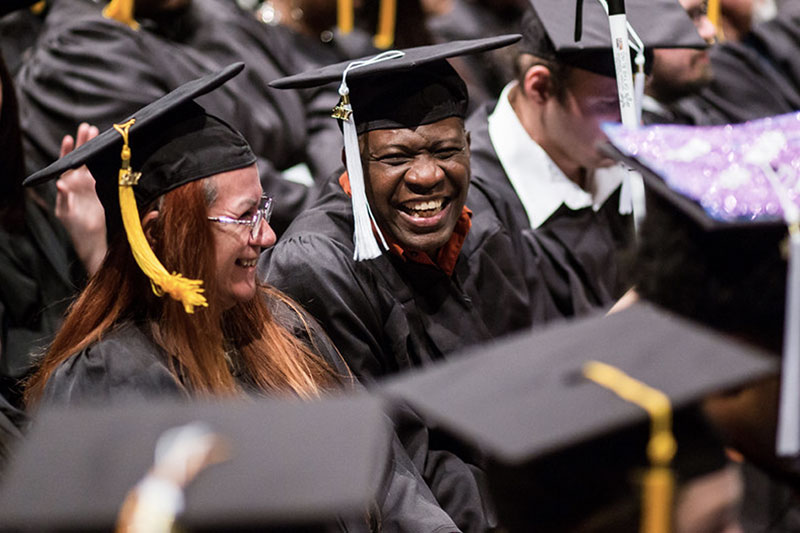When students are placed firmly at the center of the institution’s mission, vision, and strategy, the work of fostering cross-silo collaboration becomes critically important. It’s also hard to do well.
For anyone intent on remaking colleges and universities to work better for students, fostering true collaboration across long-standing, deeply entrenched silos is not optional — it’s an inescapable necessity.
Whether it’s remaking remediation, creating clear and coherent learning journeys for students, or improving outcomes for transfer students, the work of student-focused institutional transformation requires heretofore unseen levels of partnership across units, functions and hierarchies.
In their in-depth new studies that describe the practices and traits of community colleges successfully scaling implementation of Guided Pathways reforms, researchers at CCRC find that a common element shared by all the colleges featured is a demonstrated commitment to various forms of cross-functional collaboration at each stage of the design and implementation process of pathways.
“Silo-busting” is touted as the demand of our time, but what does that really mean? In rare instances, institutions have the right mix of leadership and resources to wholly remake long-standing structures in favor of more cross-functional or matrixed teams that span student services, academic affairs, finance, operations, and IT. But even under the best conditions, major structural changes are often costly and slow. And because all significant restructuring efforts bring their own host of new challenges, the promise of accelerated progress through true silo-busting always carries the threat of unintended consequences. For most resource-constrained access-oriented colleges and universities, wholesale restructuring isn’t a viable option. And yet, making colleges work better for students entails commitment to fostering cross-functional collaboration that is deep and wide. Here is where the distinction between silo-busting and silo-spanning is instructive.
In our work with dozens of colleges and universities engaged in large-scale student success work, we’ve found that leaders at every level are well served by upskilling in the art of silo-spanning.
Silo-Spanning: A World of Bridging
Unlike silo-busting, silo-spanning work assumes that traditional boundaries will continue to exist for the foreseeable future and the job to be done is less about wholesale demolition and more about co-creative navigation and cultural exchange across units. Silo-spanning accepts the world as it is, but offers the hope of a better future through new forms of relational and relationship-based problem solving or what John Dewey called “creative social intelligence.” Without the promise of a structural “fix,” silo-spanning is primarily a matter of developing the knowledge, skills, and abilities to work across boundaries in increasingly effective ways. From finding creative ways to physically locate people in other siloes, to building social networks for information sharing across functions, to the concerted relationship building between mid-level leaders across divisions, we are increasingly seeing colleges that are serious about making change attending to the human side of silo-spanning in new and creative ways.
So, what are the knowledge, skills and abilities necessary for effective silo-spanning — and how do you build them for yourself and support their development in your colleagues?
Effective silo-spanners understand the difference between technical and adaptive problems. Technical problems have clear definitions and solutions that can be implemented by fiat and with the technical expertise of one or a few leaders. In contrast, adaptive problems — in both their definitions and in their solutions — are the site of new learning because they concern complex decision-making under conditions of uncertainty, and therefore they implicate the comparatively messy domains of values, identities, power, and culture. Adaptive problems belie the notion that solutions can be simply delivered from “on high” or easily replicated in novel contexts. Unlike technical problems, adaptive problems can only be solved through the creative energies and internal motivation of those occupying multiple positions and adopting multiple lenses. For effective silo-spanners, the understanding that large-scale student success work is intrinsically adaptive, they act as though they truly understand their work will rise or fall according to the quality of relationships they are able to cultivate and foster within and across divisions.
Armed with an understanding of the deeply relationship-based nature of adaptive change, effective silo-spanners practice an approach to leadership that prioritizes the building of psychological capital (hope, efficacy, resilience and optimism) in colleagues by being curious, present and open to learning. When it comes to the work of penetrating boundaries to cultivate connections and a sense of shared purpose, they have a growth mindset and are thus able to persist in the hard work of bridging across divides amid inevitable setbacks. The best silo-spanners find ways to be comfortable with liminality, with thinking across boundaries and living on multiple sides of a barrier simultaneously.
In a recent piece summarizing research on cross-silo collaboration from a range of sectors, researchers Tiziana Cascario, Amy Edmonson & Sujin Jang argue that the most effective teams are those that contain skillful “cultural brokers” who serve as bridges capable of fostering understanding across different divisions/units within an organization and as bonding agents or “adhesives” capable of bringing people together across internal divisions/units to build new, lasting relationships.
Tips for Building a Climate and Culture of Silo-Spanning
Understand the difference between cooperation and collaboration, and build toward collaboration with true partnership as the ultimate goal:
Whether it’s about bridging or gluing, cultural brokers have skills and capabilities that point to the difference between cooperation as a short-term, transactional experience and collaboration as a longer-term, relationship-based experience focused on the cultivation of shared goals and priorities. True partnership is even a step further and is characterized by the couching of shared goals in the wider context of shared commitment to the health of the relationships among those collaborating. And when it comes to work like reforming remediation, reimagining advising, or mapping programs of study within or across institutions, all truly ambitious student-success work requires more than cooperation. As one VP of Student Success at an access-oriented university told us, “When you’re truly committed to partnership, relationships are key. With a commitment to relationships you can get through hard times, of which there are plenty, and you can mess up and have grace with one another. Without that, real transformation isn’t possible. At the bottom of it, relationships are all we have.”
Model curiosity and empathy by learning how to ask good questions & by practicing perspective-taking:
There is a plethora of resources out there for upskilling in active listening and in the art of asking good questions, and an increasing body of literature on strengthening emotional intelligence that should be viewed as highly relevant to anyone tasked with the work of making significant change that impacts faculty, staff and administrators across divisions. The first rule of cross-silo collaboration is to take the time to learn about others’ work, and to imagine what the world looks like from within different divisions. Time spent considering how student-success work looks from someone else’s perspective is time well spent for leaders at any level. Some people are naturally skillful in this, and they should be identified, supported and deployed as cultural brokers.
Have better meetings:
In our work with colleges we often find ourselves asking “The Miracle Question” which goes something like: “If you came to work tomorrow and the culture of communication and collaboration was significantly better, how would you know? What would you see happening that would tell you the condition had improved?” Interestingly, the most common answer we hear is “Our meetings would be different.” When we dig in, what we hear people saying is that too many meetings are held without clear goals, without the right people at the table, without skillful facilitation, without room for honest dialogue, and without clear outcomes. Given that most faculty, staff and administrators are stretched thin and pulled in many different directions, colleges engaging in large-scale student success work dependent on cross-silo collaboration cannot afford the habit of having bad meetings.
Lower the stakes of collaboration and incentivize silo-spanning:
The work of institutional transformation is intrinsically high-stakes work because it is students who bear the brunt of failure, and yet the work to be done is both rife with unknowns and dependent on the insights and expertise of professionals from across the college. The leaders who are most skillful in building capacity for silo-spanning find ways to seed and foster low-stakes, near-term collaborations between faculty, staff and administrators in order to help people build both the muscles and the appetite for working in new ways across real and perceived boundaries. They model growth-mindedness by sending the message that setbacks and fumbles are part of the journey toward success, and by doing so they strengthen the sense of shared purpose among those whose efforts will make or break the work over the long haul.




